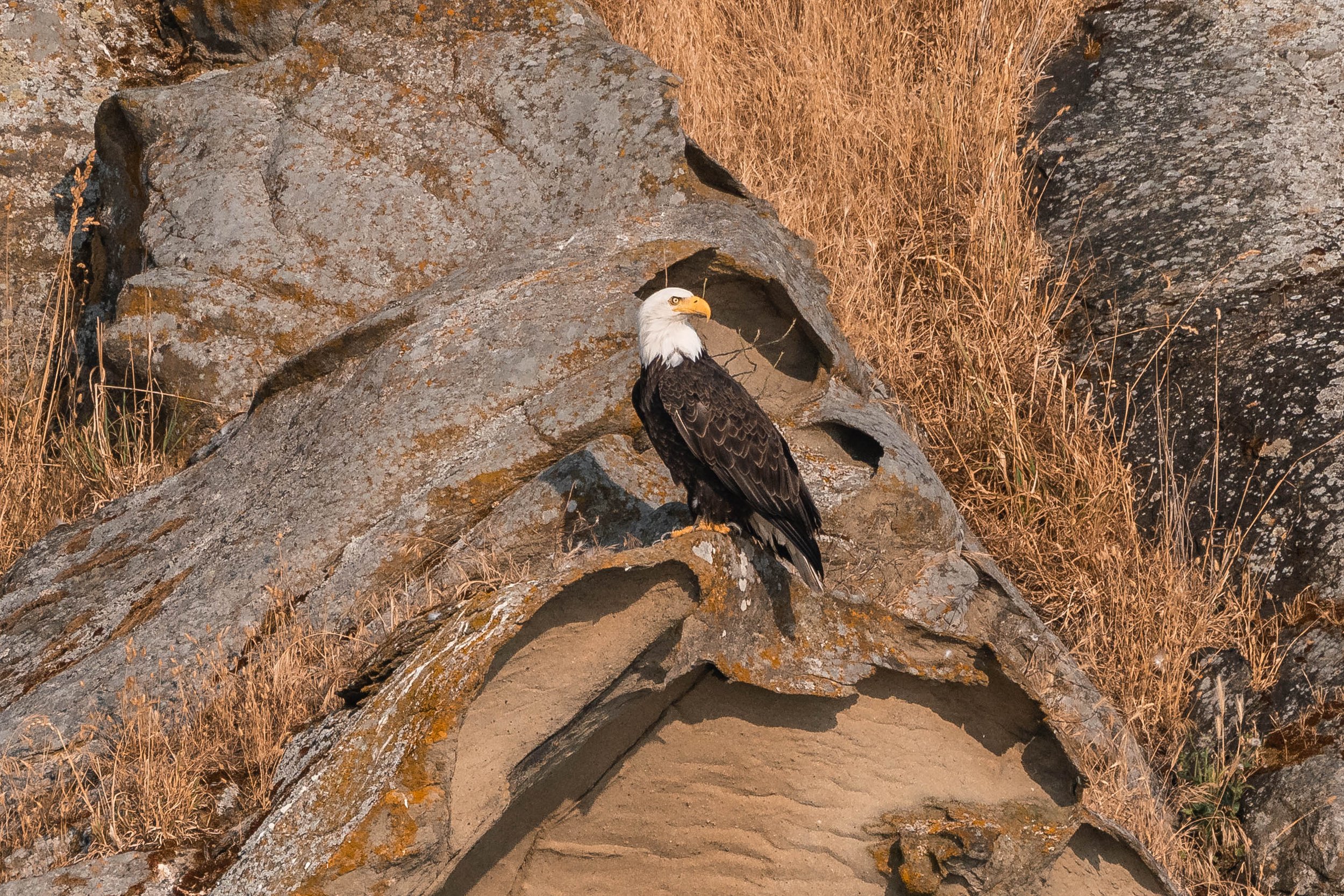June 23, 2025, 3:30 PM - Humpbacks as far as the eye can see!
The afternoon offered ideal conditions for a trip, not too hot, not too cold, just right. We pushed off the dock aboard Kula, our semi-covered vessel, and set course north into the Strait to see what the Salish Sea might reveal. Cruising along a scenic route scattered with islands, we scanned the horizon for any signs of whales. When you're out searching, your eyes quickly become attuned to subtle clues that something spectacular may be just beneath the surface.
For humpback whales, the first sign is often a tall, bushy blow rising vertically into the air, a telltale clue that a gentle giant is nearby. Soon after, you might catch a glimpse of their massive, rounded back rolling through the water, and if you're lucky, their fluke will lift high before a deep dive. Despite their size, humpbacks can be surprisingly stealthy between surfacings. It's always worth watching near bait balls or flocks of diving birds, as these often signal feeding activity below the surface.
When it comes to spotting orca, the key identifier is the dorsal fin. Orca have tall, striking fins that slice through the water like sails. Males, in particular, can sport fins nearly six feet tall. Look for swift, purposeful movement, transient orca on the hunt often zigzag through the waves. You might hear the sharp "pfft!" of their exhalation before seeing them. A slick on the surface or a sudden splash can also give them away. With patience and a sharp eye, the Salish Sea can reveal some of its most iconic wildlife, and few experiences compare to that magical first sighting.
Sure enough, something appeared in the distance. Out came the camera with the telephoto lens to confirm the ID. At least one humpback, but we suspected there might be more. There were indeed four individuals! This group, including Kata (BCY1218), Lunchable (BCY1014calf2023), Achilles (BCX2075calf2023), Kraken (BCZ0180) and one unknown friend. They seemed to be feeding and socializing. Humpback whales are filter feeders, and their feeding strategy is nothing short of extraordinary. Using a technique called lunge feeding, they charge through dense schools of small fish or swarms of krill with mouths wide open, engulfing thousands of litres of water and prey in a single gulp. Their expandable throat pleats balloon out like an accordion, and then, with the help of their massive tongue, they push the water through baleen plates that hang from the roof of the mouth, trapping only the food inside. In their summer feeding grounds, like the nutrient-rich waters off British Columbia, an adult humpback can consume up to 5,000 pounds of food per day. This intense feeding fuels the thick blubber reserves they'll rely on during their long, non-feeding migration to tropical breeding grounds.
As we watched these four continue their dinner, more activity caught our eye not far off. This tour kept our onboard Naturalist busy, between snapping ID photos and making matches, there wasn’t much downtime! This time, we identified five more individuals we had Slits (BCY0946), Eeyore (BCY1221), Eros (BCX2201), BCY0885calf2023, and Maite (BCX0565calf2022). These humpbacks were a bit more animated, treating us to pectoral fin slaps, cartwheeling breaches, and even some full-body breaching in the distance. Few sights are as thrilling as a humpback launching its entire body into the air or slamming its long pectoral fin against the water’s surface. While breathtaking for us to watch, these surface-active behaviours likely have deeper meaning. Scientists believe actions like breaching, tail lobbing, and pec slapping are important forms of communication. A breach sends a powerful, low-frequency sound through the water, an effective tool in the vast, often murky ocean.
Whether coordinating movement, expressing excitement, or reinforcing social bonds, these behaviours may help whales "speak" to one another across great distances. Occasionally, we see groups taking turns breaching or slapping the water, and it truly feels like we’re witnessing a lively conversation. Moments like these remind us how social and dynamic humpback whales are. We left the five to carry on with their antics and continued on to see who else we might encounter.
On the way home, we passed a variety of birds, some carrying nesting materials, evidence of the busy season underway. Spring and summer bring a flurry of nesting activity to the coastal cliffs and treetops of Vancouver Island. Towering above all is the bald eagle’s nest, the largest of any North American bird, sometimes reaching over nine feet wide and weighing hundreds of kilograms after years of use and reinforcement. Along the rocky islets, cormorants gather in noisy colonies, constructing messy stick nests on precarious ledges, while gulls create simple ground scrapes and fiercely guard their chicks. Closer to the water’s edge, you may spot black oystercatchers, easily identified by their vivid orange bills, tending to well-camouflaged nests nestled among the shoreline rocks. Each of these species plays a vital role in the local ecosystem, and watching them prepare for the next generation offers a glimpse into the pulse of coastal life.
After all that excitement, we returned home guided by the light of the setting sun.
Enjoy the photos below by Val Watson.
Achilles, can you spot all the scaring on their fluke?
One of the unknown dorsals.
Our unknown’s fluke, can you spot the hole?
Lunchable with Kata surfacing in front.
Lunchable going down.
Lunchable’s flukes.
Unknown fluking.
Kata fluking beside Lunchable.
Eeyor diving.
Kraken fluking.
Slit’s dorsal fin.
Slits fluking.
BCY0885calf2023 fluking.
Eros fluking.
Maite splashing up a storm.
Still going.
A nice fluke from BCY0885calf2023.
A pair of bald eagles.
Take off.
Such peircing eyes.
Watching us back.
Black oyster catchers.
Relaxing on shore.
A gull perched on a unique rock formation.
A cormorant with nesting material.
A gull with some nesting material of their own.
This bald eaglet is sunning itself.
Can you spot both chicks in the nest?
A swallow fling among the cliffs.





























